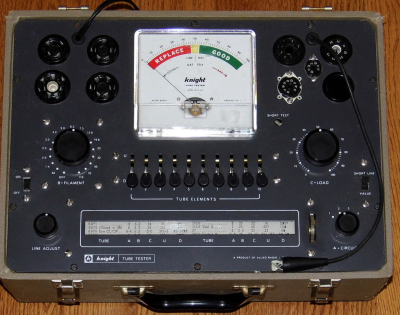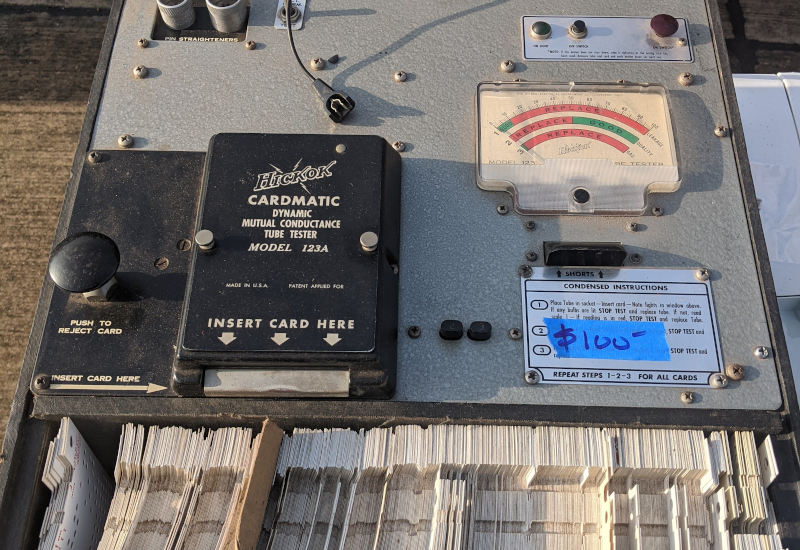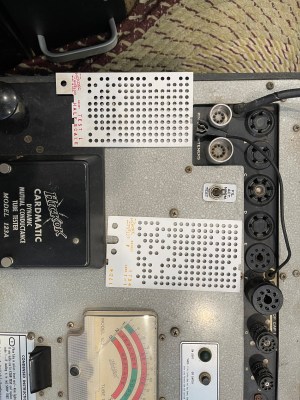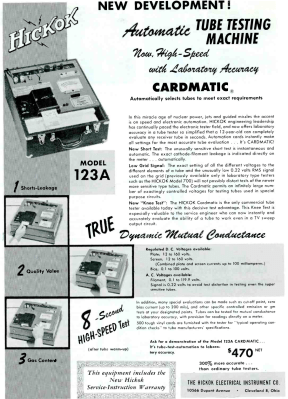We think of punched cards as old-fashioned, but still squarely part of the computer age. Turns out, cards were in use way before they got conscripted by computers. Jacquard looms are one famous example. The U.S. Census famously used punched cards for tabulating the census without anything we’d consider a computer. But in the 1950s, you might have had a punched card machine on your electronics workbench. The Hickok Cardmatic was a tube tester with a difference.
About Tube Testers
While you, as a Hackaday reader, might tear into a busted TV at your house and try to fix it, most people today will either scrap a bad set or pay someone to fix it. That’s fine today. TVs are cheap and rarely break, anyway. But this hasn’t always been the case.
In the “good old days” your expensive TV broke down all the time. Most of the parts were reliable, but the tubes would wear out. If you were the kind of person who would change your own oil, you’d probably look to see if you could spot a burned out tube and try replacing it. If you couldn’t spot it, you’d pull all the tubes out. If you were lucky, there was a diagram glued inside the cover that showed where they all went back. Then you took them to the drugstore.
You might wonder why you’d take them to the drugstore. They were one of the places that would have a tube tester in a large cabinet. You’d look up your tube and it would tell you how to set the various dials on the machine. For example, you might have to plug the tube into socket #5, turn switch 1 to position 4, switch 2 to position B, and then switch C to position 9. You’d push a button and a big meter would show you if the tube was good or bad. If the tube was bad, you’d open the cabinet, pull out a replacement tube, and pay for it at the register. (Imagine having to do this with any given transistor in your cell phone.)
Tube Testing at the Shop

For example, the Knight tube tester was more or less the drugstore model with a smaller meter and a handle. The controls were a little more technically labeled than the consumer models, too. But you still had to look up a table, twist knobs, and throw switches. You really wanted to be sure to read the table correctly, too. Being off one row or getting data from two rows could possibly kill your tube under test.
Enter Punch Cards
My friend [Tom] had a different kind of tube tester for sale at a recent hamfest. Compare this Hickok tube tester to the Knight one up above. There is a conspicuous absence of switches. Of course, there are a number of sockets because you can’t force a tube into a different socket. The meter is sort of the same, too. But instead of a table, there’s a bin of around 300 punch cards and a card reader you can see near the bottom left corner of the machine.
The card reader doesn’t have a computer — at least, we don’t think it did. It was simply a set of contacts you’d normally find behind switches on a conventional tube tester. When you slid the card in, it would move between a set of contacts. When the card hit a stop, the plunger-like switch near the card reader would pop up, engaging the contacts through the card’s holes and fixing the card. Pushing down on the plunger released the card.
You can see a better picture of a few of the cards in the other picture. Note that one of the cards was for a 17D4 tube. It tells you to use socket F and since it says, “card 1 of 1” it follows that some of the tubes needed multiple cards and tests.
The Price of Convenience
The Cardmatic shows up in ads in the late 1950s. The “new low price” for the model 121 was $250, so that implies that maybe it cost more at some point. Or perhaps it was relative to the more expenisve model 123. Sure, $250 doesn’t sound like much but adjusted that’s around $2,300 today. You had to be testing a lot of tubes to justify that kind of expenditure. For the average worker at the time, that was about a month’s take-home pay! And the 123A cost $470, even more!
Of course, according to the ad you can see here, it would test the tube in only eight seconds. Well, eight seconds after the tube warmed up. They claim the device was 300% more accurate than an ordinary tube tester, but we have no idea how’d you’d prove or disprove that.
Thanks to [bandersentv], you can actually watch a video (below) of the machine in operation. That particular model is a 121, but they are very similar. There was also a military version, the AN/USM-118B.
The operation wasn’t totally automatic. While the tube warms up, you are supposed to observe meter scale 1 which should be near zero. Then you press button 2 and verify the meter is in the green portion of scale 2. Finally — you probably guessed it — you press button 3 and make sure the meter’s needle is in the green zone on scale 3.
We shouldn’t be surprised. Despite common misconception, most processing of punched cards didn’t happen with actual computers, even for computer punched cards. Life sure is simpler now. You can get a general-purpose component tester for almost nothing. Of course, it won’t test tubes — we don’t think — but if you build a tube adapter for it, please tell us so we can cover it.
Thanks to [Tom, N3LLL] for the photos of this great old piece of test gear.


















“If you were the kind of person who would change your own oil, you’d probably look to see if you could spot a burned out tube and try replacing it. If you couldn’t spot it, you’d pull all the tubes out. If you were lucky, there was a diagram glued inside the coverof where they all went back.”
No, you picked up a brochure at the store that had dozens of pairs of number stickers, you put one on the tube after you pulled it out and it’s pair on the socket you just pulled the tube from.
Only a crazy person would remove 2 dozen tubes and not have a plan to replace them in the proper socket.
I don’t remember stickers, but I did look at the Tube Diagram inside the radio/television I pulled the tubes out of.
Iirc, tv’s had a schematic and a tube locator / identifier typically on the back masonite like cover. However, they were flimsy and many owners removed them and never replaced them. Wasn’t rocket science.
I don’t remember tubes as being unreliable.
However, tubes were the one thing a user could remove, hence the drugstore tube tester. An industry in itself, those tube testers reverted to good or bad, and some people claimed they were weighted towards bad. The one thing they might be really useful for was that ac/dc radios and tv sets (no transformers) put the filaments in series, so if one died, nothing would light up. So the user could find the one that’s bad.
Equipment was a horrible environment. Small, the tubes made them hot, likely lots of components were damaged by heat. Consumer electronics was covered with an oily dust, it didn’t just blow away.
Even if you had skill, a tv set was awful. A circuit board really hard to remove, and no easy way to run it when removed.
An LCD tv set offers great accessibility to the board(s). Most if it won’t be parts that you can buy, but not much rhere to go bad.
Tubes typically had life expectancies of 10,000 to 20,000 hours, and a typical TV had about ten of them so for a set with some age on it the MTBF would be about 1,000 hours. If you turned the TV on at daybreak and let it play til bedtime every day you could expect to replace at least one a year. When I was a child my parents had a 19-inch color Magnavox and I can remember several forays to the drugstore with a bucket of tubes as it aged.
I always bought a Sam’s Photofact for my sets.
Wait, is that $100 price tag real??? I would have bought that unit in a heartbeat. Last I checked, a working Cardmatic was in the upper hundreds.
You and me both.
If anyone has something like this near SW Virginia and wants to get rid of it, speak up. Anything in driving range (and hauling capacity) of a busted pickup, I’ll at least look at.
I worked for a company that sells vacuum tubes and we had a few of these units. Ours were modified to use a relay box that was controlled by a small DOS based program instead of cards. You keyed in the tube you wanted to test, the PC drove the relays, and that set up the cardmatic to run the test. Brilliant system. It took weeks worth of work and rendered it down to minutes.
They had their issues, and weighed enough to break bones if you dropped it on your hand while moving it. That said, they were solidly the backbone of the operation and looked to have decades of life left in them.
That sounds really strange. You are talking about a tube tester at a time, when PCs (even when it was just DOS) were already available? So ICs and transistors already existed. Who on earth needed tubes any more? Except for CRTs and some exotic microwave amplifiers like TWTs.
Guitarists, people who didn’t want to throw away big console tvs
He is referring to a modern adaptation of vintage Cardmatic testers, giving them new life: http://www.tubesontheweb.com/matic.htm